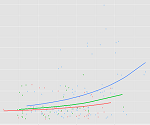Mediation indicates that a mediator M is the causal link in the effect between an independent variable X and a dependent variable Y.
How to test mediation has become a very hot topic of statistical research in the past 10 years, and there are many new advances.
In this webinar, we’ll discuss a number of issues, new and old, in mediation, including the Baron & Kenny 4-step approach, the difference between mediation and moderation, Sobel and bootstrap tests for indirect effects. (And of course, what all these terms mean.)
Note: This training is an exclusive benefit to members of the Statistically Speaking Membership Program and part of the Stat’s Amore Trainings Series. Each Stat’s Amore Training is approximately 90 minutes long.
About the Instructor

Karen Grace-Martin helps statistics practitioners gain an intuitive understanding of how statistics is applied to real data in research studies.
She has guided and trained researchers through their statistical analysis for over 15 years as a statistical consultant at Cornell University and through The Analysis Factor. She has master’s degrees in both applied statistics and social psychology and is an expert in SPSS and SAS.
Not a Member Yet?
It’s never too early to set yourself up for successful analysis with support and training from expert statisticians.
Just head over and sign up for Statistically Speaking.
You'll get access to this training webinar, 130+ other stats trainings, a pathway to work through the trainings that you need — plus the expert guidance you need to build statistical skill with live Q&A sessions and an ask-a-mentor forum.
Item Response Theory (IRT) refers to a family of statistical models for evaluating the design and scoring of psychometric tests, assessments and surveys. It is used on assessments in psychology,  psychometrics, education, health studies, marketing, economics and social sciences — assessments that involve categorical items (e.g., Likert items).
psychometrics, education, health studies, marketing, economics and social sciences — assessments that involve categorical items (e.g., Likert items).
In this webinar, you will learn about:
- The key ideas and techniques of IRT, with examples from educational assessment
- The Rasch Model and the Graded Response Model — two of the most commonly-used IRT models
- A range of analytic techniques that should be used in conjunction with IRT
This webinar will introduce you to the basic ideas and applications of IRT, and show how you can acquire the skills necessary to conduct IRT analysis at the professional level.
Note: This training is an exclusive benefit to members of the Statistically Speaking Membership Program and part of the Stat’s Amore Trainings Series. Each Stat’s Amore Training is approximately 90 minutes long.
About the Instructor
 David Lillis is an applied statistician in Wellington, New Zealand.
David Lillis is an applied statistician in Wellington, New Zealand.
His company, Sigma Statistics and Research Limited, provides online instruction, face-to-face workshops on R, and coding services in R.
David holds a doctorate in applied statistics and is a frequent contributor to The Analysis Factor, including our blog series R is Not So Hard.
Not a Member Yet?
It’s never too early to set yourself up for successful analysis with support and training from expert statisticians.
Just head over and sign up for Statistically Speaking.
You'll get access to this training webinar, 130+ other stats trainings, a pathway to work through the trainings that you need — plus the expert guidance you need to build statistical skill with live Q&A sessions and an ask-a-mentor forum.
Many variables we want to measure just can’t be directly measured with a single variable. Instead you have to combine a set of variables into a single index.
But how do you determine which variables to combine and how best to combine them?
Exploratory Factor Analysis.
EFA is a method for finding a measurement for one or more unmeasurable (latent) variables from a set of related observed variables. It is especially useful for scale construction.
In this webinar, you will learn through three examples an overview of EFA, including:
- The five steps to conducting an EFA
- Key concepts like rotation
- Factor scores
- The importance of interpretability
Note: This training is an exclusive benefit to members of the Statistically Speaking Membership Program and part of the Stat’s Amore Trainings Series. Each Stat’s Amore Training is approximately 90 minutes long.
About the Instructor

Karen Grace-Martin helps statistics practitioners gain an intuitive understanding of how statistics is applied to real data in research studies.
She has guided and trained researchers through their statistical analysis for over 15 years as a statistical consultant at Cornell University and through The Analysis Factor. She has master’s degrees in both applied statistics and social psychology and is an expert in SPSS and SAS.
Not a Member Yet?
It’s never too early to set yourself up for successful analysis with support and training from expert statisticians.
Just head over and sign up for Statistically Speaking.
You'll get access to this training webinar, 130+ other stats trainings, a pathway to work through the trainings that you need — plus the expert guidance you need to build statistical skill with live Q&A sessions and an ask-a-mentor forum.
Linear, Logistic, Tobit, Cox, Poisson, Zero Inflated… The list of regression models goes on and on before you even get to things like ANCOVA or Linear Mixed Models.
In this webinar, we will explore types of regression models, how they differ, how they’re the same, and most importantly, when to use each one.
Note: This training is an exclusive benefit to members of the Statistically Speaking Membership Program and part of the Stat’s Amore Trainings Series. Each Stat’s Amore Training is approximately 90 minutes long.
About the Instructor

Karen Grace-Martin helps statistics practitioners gain an intuitive understanding of how statistics is applied to real data in research studies.
She has guided and trained researchers through their statistical analysis for over 15 years as a statistical consultant at Cornell University and through The Analysis Factor. She has master’s degrees in both applied statistics and social psychology and is an expert in SPSS and SAS.
Not a Member Yet?
It’s never too early to set yourself up for successful analysis with support and training from expert statisticians.
Just head over and sign up for Statistically Speaking.
You'll get access to this training webinar, 130+ other stats trainings, a pathway to work through the trainings that you need — plus the expert guidance you need to build statistical skill with live Q&A sessions and an ask-a-mentor forum.
If you’ve ever done any sort of repeated measures analysis or mixed models, you’ve probably heard of the unstructured covariance matrix. They can be extremely useful, but they can also blow up a model if not used appropriately. In this article I will investigate some situations when they work well and some when they don’t work at all.
The Unstructured Covariance Matrix
 The easiest to understand, but most complex to estimate, type of covariance matrix is called an unstructured matrix. Unstructured means you’re not imposing any constraints on the values. For example, if we had a good theoretical justification that all variances were equal, we could impose that constraint and have to only estimate one variance value for every variance in the table.
The easiest to understand, but most complex to estimate, type of covariance matrix is called an unstructured matrix. Unstructured means you’re not imposing any constraints on the values. For example, if we had a good theoretical justification that all variances were equal, we could impose that constraint and have to only estimate one variance value for every variance in the table.
But in an unstructured covariance matrix there are no constraints. Each (more…)
Need to dummy code in a Cox regression model?
Interpret interactions in a logistic regression?
Add a quadratic term to a multilevel model?
 This is where statistical analysis starts to feel really hard. You’re combining two difficult issues into one.
This is where statistical analysis starts to feel really hard. You’re combining two difficult issues into one.
You’re dealing with both a complicated modeling technique at Stage 3 (survival analysis, logistic regression, multilevel modeling) and tricky effects in the model (dummy coding, interactions, and quadratic terms).
The only way to figure it all out in a situation like that is to break it down into parts. (more…)



 David Lillis is an applied statistician in Wellington, New Zealand.
David Lillis is an applied statistician in Wellington, New Zealand. The easiest to understand, but most complex to estimate, type of
The easiest to understand, but most complex to estimate, type of  This is where statistical analysis starts to feel really hard. You’re combining two difficult issues into one.
This is where statistical analysis starts to feel really hard. You’re combining two difficult issues into one.